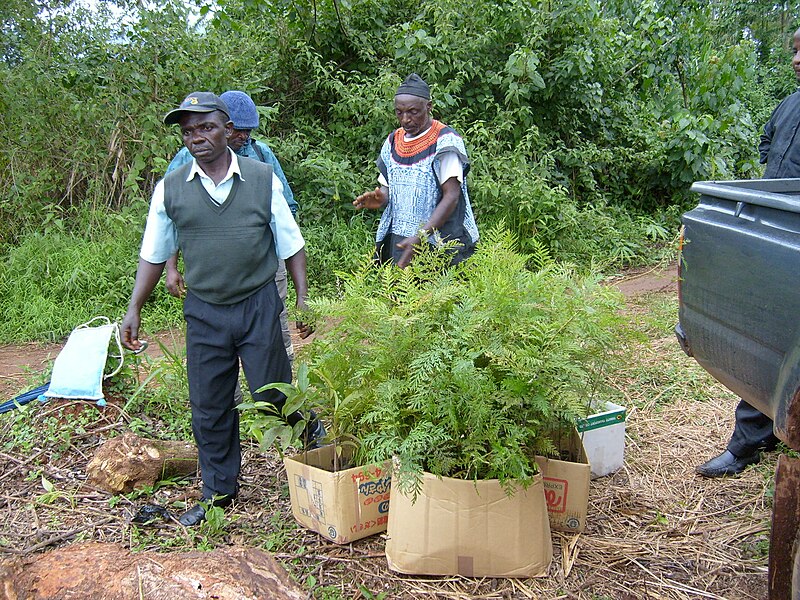The other day I went to a free public lecture at ZEF by Roger Leakey, a crop physiologist and tree biologist who presented a new concept for Tropical Agriculture: Agroforestry! As he explained, while most subsistence farmers in tropical areas rely on cereal crops for their day-to-day survival, learning how to domesticate and use trees might help them in a multitude of ways:
- depleted soils can be restored by using leguminous trees which fix nitrogen in the soil, similar to a natural fertilizer
- if traditionally important trees are integrated in the on-farm production, new local market opportunities arise and enable them to shift from pure self-sufficiency
- additionally, tree products also lend themselves to low-level processing (e.g. drying, shelling), which adds value, and could lead to further regional commercialization and poverty alleviation of the producing families

In addition, trees are great in carbon sequestration (which would make such projects eligible for carbon credits), aid in preserving and creating new ecosystems, and are multifunctional – if the right tree is selected, you might use a variety of its products, including leaves, fruits, the bark, etc.
Speaking of tree selection – in Leakey’s pilot project in Cameroon, his team of researchers actually went out and asked the farmers which tree products they thought would be suitable for the local market and what trees they would like to grow, if they knew how. This participatory approach was completely unheard of and the locals were stunned, noting that normally white people just told them what to do. He also credited the participatory approach as one of the reasons of the project’s success, since locals were genuinely excited and motivated once the project got started. Some final thoughts on benefits and limits:
One of the most inspiring details in my opinion was the fact that you could select trees also by means of when they produce the most income over the year (e.g. when is the fruit ripe, when the nuts, etc.). When Leakey asked his group of farmers, the women unanimously preferred the tree that generated income in August – when their expenses rose dramatically due to tuition fees and school uniform cost. I also really liked that the focus was on trees traditionally used for nuts, fruits and medicinal purposes, which ensured that they were ecologically suited for the region and preserved local species and customs at the same time.
On the other hand, some issues that are still unresolved are linked to intellectual property rights (the process of domesticating a wild species takes a lot of work and rewards should be given to the community which did that work), land rights and government involvement (if the government is just a bystander and not an active participant, and legally own the land that communities are using, investing in long-term projects might be connected to risks for the farmers), the trade-off between farmers and pastoralists who normally let their cattle graze on the farmers’ land during the fallow season, and the potential of trading off domestication with biodiversity loss should the project really take off in the long run.
For more on the subject, check out this interview with Roger Leakey – he also recently published a book about his research called “Living with the Trees of Life”. He is also Vice-Chairman of the International Tree Foundation.
It is really interesting story to read. Trees are very crucial for the livelihood of poor farmers in developing countries. I am not talking about tree crops like mango trees, but normal trees. It is almost equally important as other crops. It is used to generate income for farmers selling for firewood, house construction etc. The problem , however, is that farmers have no option than integrating in to their farm production trees that they traditionally knew and familiar with. There is far less options to diversify to multifunctional trees to optimize the benefit from trees. So, this concept of agro-forestry has paramount importance for poor farmers in Africa. I really like the preference of the woman -tree that generated income in August. She is right, there are some critical season where revenues are few and expenditures are quite high. This is lean season. During this time, no grain in the storage because they have already sold all what they produced right after harvest when price is quite low to pay tax and debt, access to market is quite difficult because it is rainy season and roads are full of mud, bridges are destroyed due to heavy rain so forth. This season is called wet-dry season in rural sociology terms. It is wet because it is rainy season and dry because there is no food available for the poor. Typical example for this – poor farmers who live in marginalized rural area of Ethiopia where i am from. So, during this period of the year the only source of income to finance their consumption is by selling fire woods and cow dungs 🙁 Thank you Janina for such interesting topic to discuss 🙂
Thanks for your valuable input, Tesfaye! It’s always so rewarding to hear your first-hand experience! As a side-note, the presenter said that unfortunately, East Africa was one of the regions with the smallest number of local tree species suitable for cultivation and for further on processing – however, I think the first part (the nitrogen-fixing) was possible and very important for that region as well. And even if there is not a huge number of options, even one or two would suffice to make an important impact for the livelihoods of small-scale farmers, right? Looking forward to many more discussions! =)